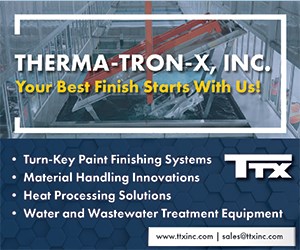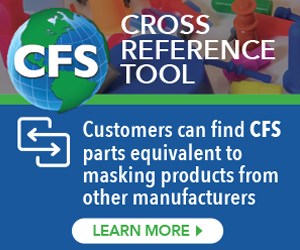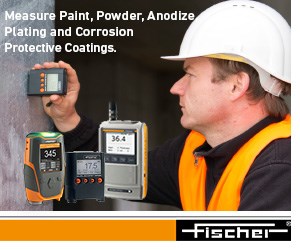POWDER COATING
Narrow by Powder Coating Product Category
- Aerosol-Packaging Equipment & Services
- Air Make-Up Systems
- Air-Sampling Equipment (In-Plant Environment)
- Analytical Equipment, X-ray Fluorescence
- Associations, Tradeshows & Professional Groups
- Breathing Systems, Air Filtration
- Burners, Gas
- Burners, Gas & Oil (Combination)
- Burners, Oil
- Chillers
- Clamps, Anodizing, Plating & Powder Coating
- Coatings, Electrocoatings
- Coatings, Fluorocarbon
- Coatings, High Solids
- Coatings, In Mold
- Coatings, Military & Government Specification
- Coatings, Plural-Component
- Coatings, Radiation-Curable
- Coatings, Strippable Plastic
- Coatings, Waterborne
- Coatings, Zinc-Rich
- Compressors, Air
- Computer Control Systems for Finishing Processes
- Computer Software for Finishers
- Consultants, Independent, Organic Finishing
- Consultants, independent, powder coating
- Controls, Air Pressure
- Controls, Burner
- Controls, Color
- Controls, Paint Color-Changing
- Controls, Temperature
- Conveyor Belts
- Conveyor Cleaning Equipment
- Conveyor Hangers, Rotating
- Conveyor Loading/Unloading Equipment, Automatic
- Conveyor Lubricators
- Conveyors, Belt
- Conveyors, Chain-on-Edge Spindle-type
- Conveyors, Flat Pallet
- Conveyors, Inverted Power-and-Free
- Conveyors, Magnetic Belt
- Conveyors, Overhead Chain
- Conveyors, Overhead Power-and-Free
- Conveyors, Overhead Traveling Hoist
- Conveyors, Wicket
- Courses in Paint Application & Related Processes
- Curing Equipment, Ultraviolet (UV) & Electron Beam (EB)
- Deionizers, Demineralizers
- Dryers, Compressed Air
- Environmental Test Chambers
- Equipment Engineering & Installation Services
- Filter Belts, Powder-Coating Recovery
- Filter Media for Paint
- Filters, Breathing Air
- Filters, Compressed Air
- Filters, Spray Booth
- Filtration Equipment, Paint
- Finishing Systems, Paint, Porcelain Enamel, Powder, Conveyorized
- Flooring, Chemical-Resistant
- Fluxes, Tinning & Soldering
- Gloves, Work
- Heaters, Paint Drum
- Hoists, Traveling: Automatically Controlled
- Hoists, Traveling: Manually Controlled
- Hoses, Air or Liquid
- Humidity Cabinets
- Infrared Heaters, Electric
- Infrared Heaters, Gas
- Inks, Metal Color-Coding
- Inks, Metal Decorating
- Laboratory Supplies, Painting
- Lamps, Color Matching
- Magnetic Paint Racks
- Masking Caps, Discs, Plugs
- Masking Devices, Spray Painting
- Masking, Customized
- Masks, Solder Dip
- Metal Tubing
- Mixers, Stirrers
- Noise-Control Enclosures, Devices
- Nozzles, Spray Painting
- Ovens, Convection
- Ovens, High-Velocity
- Ovens, Infrared
- Oven-Temperature Monitors/Curing Analyzers
- Paint Dispensing Equipment
- Paint Overspray Recycling/Recovery Systems/Services
- Paint Strainers
- Paint, Electrocoating
- Paint, Touch-up
- Paint-Circulating Systems
- Paint-Curing Equipment, Catalyst-Vapor
- Paint-Curing Equipment, Ultraviolet (UV) & Electron-Beam (EB)
- Paint-Drum Rotators, Mixers, Shakers
- Painting Equipment for Test Panels
- Painting Equipment, Air Assisted Airless Spray
- Painting Equipment, Air Atomize Spray
- Painting Equipment, Airless Spray
- Painting Equipment, Centrifugal
- Painting Equipment, Curtain Coating
- Painting Equipment, Dip Coat
- Painting Equipment, Dip Spin
- Painting Equipment, Electrocoating
- Painting Equipment, Electrocoating: Eductors
- Painting Equipment, Electrocoating: Membranes
- Painting Equipment, Electrostatic Spray
- Painting Equipment, Electrostatic: High-Speed Rotational Application
- Painting Equipment, Flow Coat
- Painting Equipment, High-Volume/Low-Pressure Air Atomize
- Painting Equipment, Hot Spray
- Painting Equipment, Plural-Component Spray
- Painting Equipment, Roller Coat
- Painting Equipment, Spray-Mask Decorating
- Part Recognition
- Pigments, Paint
- Pipe & Fittings, Chemical Resistant
- Pipe-Line Strainers
- Powder Coating Equipment, Electrostatic Spray
- Powder Coating Equipment, Fluidized Bed
- Powder Coating Equipment, Fluidized Bed, Electrostatic
- Powder Coating Recovery Systems
- Powder Coating Sieves, Screening Devices, Sifters
- Powder Coating Systems, Engineering & Installation
- Powder Coating Testing Equipment
- Powder Coatings
- Powder Coatings, Thermoplastic
- Powder Coatings, Thermoset
- Power Supplies for Electrostatic Processes
- Programmable Controllers
- Protective Packaging Products
- Pumps, Paint
- Pumps, Paint, Plural-Component Metering
- Rack Stripping Equipment
- Rack Trucks
- Racking/Unracking Machines
- Racks, Plating, Painting & Anodizing
- Resins, Paint & Powder Coating
- Robots, Painting & Powder Coating
- Safety Equipment & Materials, Personal
- Safety Storage Buildings, Enclosures
- Software for Finishing
- Spray Booth Cleaning Materials
- Spray Booth Coatings
- Spray Booth Compounds, Water Wash
- Spray Booth Lighting Fixtures
- Spray Booth Sludge Removal Systems
- Spray Booths, Paint & Powder Coating
- Spray-Gun Controls, Memory
- Spray-Gun Movers, Paint or Powder Coating
- Spray-Gun Washers
- Spray-Mask-Painting Barrier Coatings
- Stop-Off Coatings, Waxes
- Tanks, Paint (Pressure Feed)
- Tape, Masking for Plating & Painting
- Temperature Indicators
- Temperature Recorders
- Testing Equipment, Abrasion Resistance
- Testing Equipment, Accelerated Weathering
- Testing Equipment, Air-Motion
- Testing Equipment, Color
- Testing Equipment, Electrochemical Corrosion
- Testing Equipment, Gloss
- Testing Equipment, High-Voltage Electrostatic
- Testing Equipment, Impact Resistance
- Testing Equipment, Salt Spray
- Testing Equipment, Slip & Friction
- Testing Equipment, Thermal Cycling
- Testing Equipment, Thickness of Coating
- Testing Service, Accelerated Weathering
- Thermometers, Pyrometers
- Used Equipment
- Vacuum Cleaning Equipment for Powder Coating Systems
- Valves
- Viscosimeters
FAQ: Powder Coating
What is the best way to powder coat metal furniture (i.e., cast iron, steel fabrications, aluminum) to achieve high performance and longevity from the coating?
Outdoor performance brings a variety of elements into play that break down a coating. Sun, wind, rain and temperature can take a toll on even the toughest coatings. Before you select a coating, you need to decide how high you want to reach. The levels of performance can range from modest expectations to extremely high standards. As performance increases, so do process needs and cost.
Pretreatment could be as simple as a cleaning and iron phosphate process. This will give you a good, clean surface and good powder adhesion to the substrate. It does not add any appreciable gain in corrosion resistance if the coating is damaged and moisture gets through to the substrate. To add corrosion resistance to the substrate, you will need to add a more robust conversion coating, such as zirconium oxide, zinc phosphate or chrome/non-chrome treatment. The decision on what to use relates to the substrates being coated and how reliant you want to be on the pretreatment for corrosion protection.
Another way to enhance corrosion protection is the use of a high-quality primer. A primer layer offers more benefits than may be obvious: it adds to thickness for better moisture resistance and mechanical performance, it rounds out the edges for better coverage and protection against corrosion in these critical areas and it helps to fill areas that might be missed with a single coat.
You should also consider a washer for cleaning and application of a conversion coating. Zirconium oxide or similar transitional metal processes should be a good selection for a wide variety of metals. Having the options to blast or wash will give you a good start on the process.
(Source: What's the Best Coating Method for Extended Outdoor Performance?)
What are some ways to increase profits for the powder coating operations?
- Start by reviewing your quoting practices. Gather all your costs (labor, material, fixed business cost, line burden, scrap and rework, etc.) and divide it out by the production rate to get an accurate per-piece price based on the production rate. Then you will know your real cost per part and be in a good position to add the profit margin you need.
- In racking, pay attention to spacing in the vertical and horizontal. Be aware of improved positions or density. As long as the coaters can keep up with the amount of surface going through the booth, it is a good idea to rack parts densely. You may want to invest in special racking for some parts so that they are hung at the optimum density. Simple hooks are useful but sometimes they do not take proper advantage of the available space on the line.
- Be sure your operators have the proper training and understanding of what to coat, how to use the gun and how much powder is needed to achieve the desired performance. If they are not efficient or you have too many rejects, the cost of coating is artificially high. Check film build regularly.
- Limit color change frequency and work on short color-change time by training your people and using the best equipment available. Plan production to minimize downtime and lost powder. Maintain your system by scheduling cleaning and repair and keeping things in good working condition. Damaged or worn system components reduce efficiency and raise cost. Keep spare parts inventory and make sure the guns are always in good working order.
- Check your earth ground to make sure that your parts are always grounded during coating. Poor grounding will increase rejects (hook scars, light coating, orange peel) and decrease application efficiency. Use good powder products. Some coaters shop for lower cost powder by the pound. Focus on applied cost, and that may mean using a material that costs more per pound but covers more surface because of better ingredients. Not all powders are created equal.
(Source: Powder Coating Clinic: Making Powder Lines More Profitable)
Which offers the best long-term protection from corrosion, powder coating or galvanizing?
There are many options within the powder coating world for an outdoor system. The surface can be pretreated with zinc, blasted and zinc primed, coated with a fusion bond epoxy (FBE) primer coat, or layered in other ways that will affect the outdoor weathering and abrasion resistance you are going to need in your application.
There are also some very tough thermoplastic coatings that might work well. The best option is probably a layer of FBE and a layer of tough topcoat. The FBE provides a very tough and thick coating with great resistance to moisture penetration. Still, galvanizing might be a better option. It is durable and any areas that are worn from abrasion may show localized corrosion, but it should not spread due to the zinc layer of the galvanizing. Localized areas can be repaired also by application of a cold galvanized spray. The abrasion of the forklift will eventually wear out any coating, so you will want something that is relatively easy to repair.
(Source: Powder Clinic: Powder Versus Galvanizing)
How do you choose the right filler for your powder coating process?
There are a few products that can be used for this task. The trick is to find one that is cost effective, easy to apply and works reliably well. Spectrum Powder Manufacturing in Calgary offers a higher temperature vinyl caulk that can work. It can be applied from the tube over a clean and dry surface and smoothed with an air-driven tool. Another product that has worked well for powder coaters is Thermobond-3. It is a good filler that is simple to apply and easy to sand. Lab Metal Epoxy Putty by Alvin Products has also been used by some coaters. It is always recommended to test some parts before committing to a full-scale production batch of filled parts, however.
What coating system gives the best long-term coating performance?
For the best protection against corrosion and UV exposure, choose an electrocoat and a super durable powder coating. Whether you have a zirconium pretreatment system or zinc phosphate pretreatment system, either will give very good corrosion performance. The super durable powder coating will give the best weathering performance, meaning color fade and gloss retention in sun-exposed areas.
There are other options, such as a two-layer powder coating system where the primer layer is an epoxy or an epoxy polyester hybrid. The primer could also include a sacrificial element such as zinc. It requires a significant loading of zinc to get the long-term performance and that significantly increases the specific gravity, which reduces the square footage per pound of powder coating. It also increases the cost per pound. It’s a pretty big economic impact as it requires more powder and costs more. Newer epoxy primers can give very good performance without the zinc additive.
(Source: Powder Coat Systems with the Best Long-Term Performance)
Is it possible to improve efficiency in a batch operation with no powder recovery?
Like all discussions on application efficiency, it starts with confirmed and consistent earth grounding. Make sure you have good ground by keeping your hooks and the hook point on your rail or cart clean and attaching a cable to the ground source if necessary.
After you confirm that the ground is always good, you need to focus on spray gun setup. Flow rate should be optimum, starting somewhere in the midrange. If it is too low, the efficiency may be good but it could take too long to build film and too long to finish the part. If it is too high, the transfer efficiency will be lower and the overspray volume will be higher. On a volume-based system, you should start with a setting of about 40% powder and 4.0 total air. A pressure-based system should be around 25 to 30 PSI with just enough secondary air to create a smooth and consistent pattern. Check film thickness regularly to make sure you are getting the correct range.
You should also optimize the voltage/micro-amp settings. If the surface is simple to coat, you can run at full voltage and not worry about limiting current. If the part has Faraday areas or a more complex shape, you should use factory presetting for better penetration or limit the current. If you are doing a second coating, you should limit current, move the gun a little farther from the target and increase the flow a little.
Make sure the parts are racked so that the operator cans see well and reach all surfaces as best as possible. Poor rack position can cause increased overspray. Also ensure that all operators have proper training on technique and settings.
Get Listed!
Thousands of people visit this Supplier Guide every day to source equipment and materials. Get in front of them with a free company profile.






